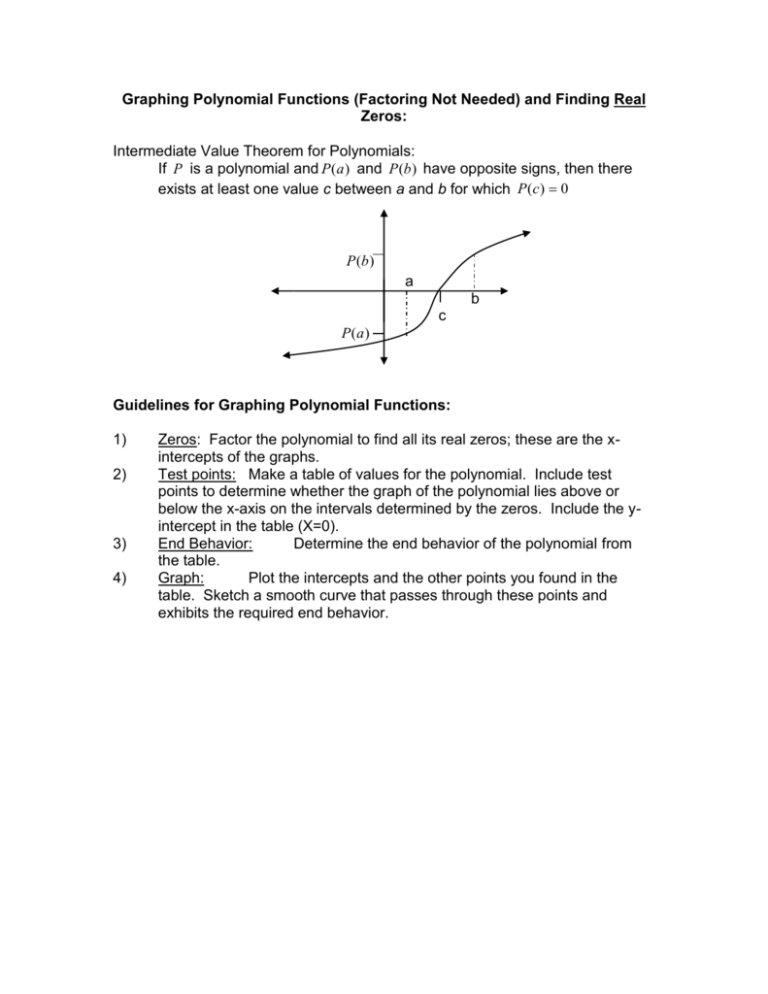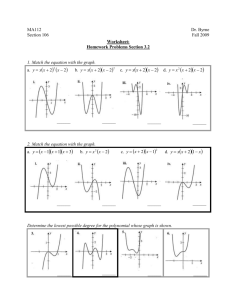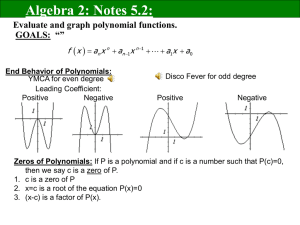Graphing Polynomial Functions (Factoring Not Needed) and Finding
advertisement

Graphing Polynomial Functions (Factoring Not Needed) and Finding Real Zeros: Intermediate Value Theorem for Polynomials: If P is a polynomial and P (a ) and P (b ) have opposite signs, then there exists at least one value c between a and b for which P (c ) 0 P (b ) a b c P (a ) Guidelines for Graphing Polynomial Functions: 1) 2) 3) 4) Zeros: Factor the polynomial to find all its real zeros; these are the xintercepts of the graphs. Test points: Make a table of values for the polynomial. Include test points to determine whether the graph of the polynomial lies above or below the x-axis on the intervals determined by the zeros. Include the yintercept in the table (X=0). End Behavior: Determine the end behavior of the polynomial from the table. Graph: Plot the intercepts and the other points you found in the table. Sketch a smooth curve that passes through these points and exhibits the required end behavior. Graph the following: 1) P( x) x( x 3)( x 1) Local Extrema and Maxima of Polynomials: (a,b) Local Maximum (c,d) Local Minimum We say that (a,b) is the local maximum point and that (c,d) is the local minimum point. The set of all local maximum and minimum points on the graph of a function is called its local extrema. Local Extrema of Polynomials: If P (x) a n x n a n 1 x n 1 a1 x a0 is a polynomial of degree n, then the graph of P has at most n 1 local extrema. (it is possible for the polynomial to have less then n 1 , but cannot have more then n 1 ) For the following a) find the real zeros of the polynomial b) graph the polynomial 1) P( x) x( x 1) 2 ( x 2) 2) P( x) x 2 (2 x 3)( x 1) Finding Zeros of a Polynomial Function: To find the real zeros of a polynomial function we must first factor the polynomial function: Find the real zeros of the following polynomial functions: 1) 2) P( x ) m 3 m 2 m 1 P( x) 2 x 4 x 3 3x 2 3) P( x) 3x 4 5x 3 12 x 2 4) P( x ) x 3 2 x 2 4 x 8 5) P( x) x 3 3x 2 4 x 12 6) P( x) 2 x 3 x 2 18x 9 7) P( x) x 5 16 x 3 8) P( x) x 7 25x 5 NOTE: Zeros=Solutions=Roots










